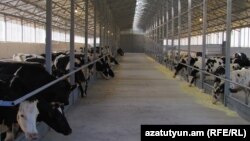“There is acute demand for labor in construction, agriculture, information technology, the manufacturing sector and even the taxi business,” Kerobian wrote on Facebook this week.
He said Armenians should therefore urge their relatives and friends working abroad to return home and help “strengthen and develop our country.”
The appeal was met with skepticism and even derision in a country that has long suffered from high unemployment.
According a World Bank report released in March 2021, Armenia’s official unemployment rate reached 18 percent in September 2020, up by one percentage point from the pre-pandemic period. The Armenian economy shrunk by 7.6 percent last year due to the pandemic compounded by the autumn war in Nagorno-Karabakh.
Although the economy returned to growth this spring, the lifting by some countries, notably Russia, of coronavirus-related entry bans for Armenian citizens led to a sharp rise in labor out-migration. Government data suggests that some 80,000 people left Armenia in the first half of this year.
Kerobian insisted on Thursday that “there are many available jobs in Armenia” at present. “Those who are trying their luck abroad would definitely find decent jobs here, especially in the sectors mentioned by me,” the minister told reporters.
“There is even a lack of shepherds in villages,” he said. “They can’t find shepherds and have to hire them from various countries.”
Individuals running two private firms involved in animal husbandry confirmed this when they spoke with RFE/RL’s Armenian Service.
Armine Melkonian, the chief executive of the Navasard Agro firm based in the town of Sevan, said that even last year it had trouble hiring workers for its sheep and poultry farms despite offering to pay them at least 250,000 drams ($500) a month and cover their food and accommodation expenses.
According to official statistics, the average monthly wage in Armenia currently stands at 216,000 drams. It is considerably lower in rural areas that have long had the highest poverty rates.
“Last year, we brought in two workers from Tajikistan,” said Melkonian. “In March and April this year, we again posted job announcements and told our acquaintances in local villages to ask people if they are willing to work for us on good terms.”
“There was again zero reaction. So we again called our friends in Tajikistan so that they send two more workers here,” she said.
Sasun Asatrian, a co-owner of the Agroholding firm based in another small town, Spitak, said it had to hire Indian migrants for the same reason. Asatrian blamed the worker shortages on Armenians’ seasonal economic migration to Russia and the fact that “young people shy away from agricultural work.”
Kerobian spoke of an increased number of job vacancies posted online and monitored by the Armenian Ministry of Economy. But he gave no concrete figures.
A Yerevan-based private employment agency, Staff.am, currently lists about 1,200 vacancies on its website. One of its managers, Nazeli Badalian, confirmed that job openings have indeed increased of late.
Information technology specialists are now Armenia’s most in-demand workers, Badalian told RFE/RL’s Armenian Service.
Kerobian also pointed to data from the State Revenue Committee (SRC) which shows the number of officially registered workers in the country rising by 8,305 in June to a new record high of 643,000. The SRC has not clarified whether the increase primarily resulted from its crackdown on the informal sector of the economy or new jobs created by Armenian firms.






